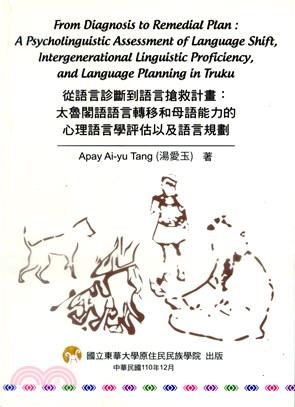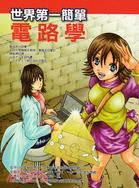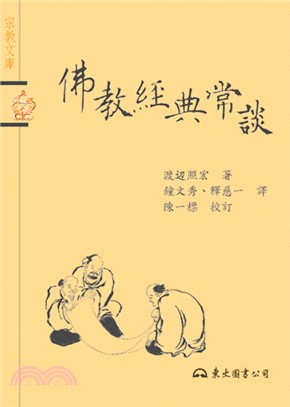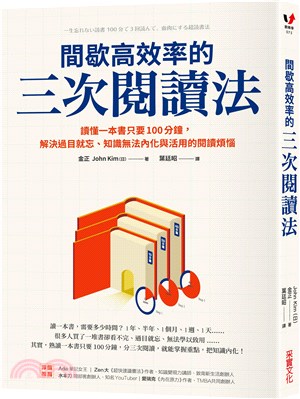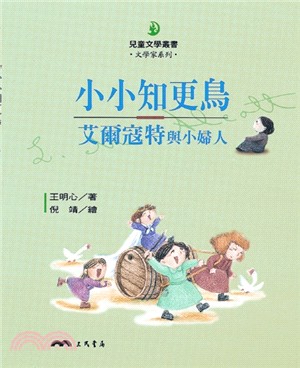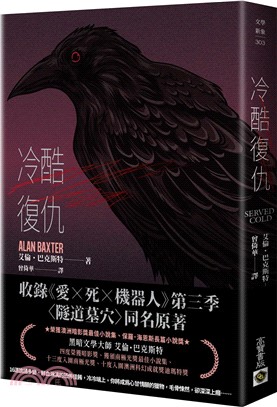從語言診斷到語言搶救計畫:太魯閣語語言轉移和母語能力的心理語言學評估以及語言規劃
- ISBN13:9789860653267
- 出版社:國立東華大學
- 作者:Apay Ai-yu 湯愛玉著
- 裝訂/頁數:平裝/334頁
- 規格:21cm*15cm*2.5cm (高/寬/厚)
- 版次:1
- 出版日:2021/12/01
定 價:NT$ 400 元
優惠價:85 折 340 元
領券後再享88折
領
團購優惠券A
8本以上且滿1500元
再享89折,單本省下37元
再享89折,單本省下37元
領
無庫存,下單後進貨(採購期約30個工作天)
可得紅利積點:10 點
相關商品
商品簡介
目次
商品簡介
雖然臺灣語言振興政策已執行二十多年,但原住民族語言仍存在不同程度的衰退,有些族語更面臨滅絕的危機。對許多族人而言,族語並非日常生活用語;族語傳承亦出現斷層。為扭轉語言衰退現象,有效進行族語復振,我們必須先掌握語言使用的現況。因此,本文以太魯閣語為研究對象,從心理語言學的觀點調查研究太魯閣語相對於台灣華語的語言強度、太魯閣語能力的世代差異,並提出太魯閣部落語言保存規劃方案。具體而言,本研究目標為:(一)應用「夏威夷語言強度評估標準」(Hawai’i Assessment of Language Access, HALA)評估太魯閣語的相對強度。(二)評估不同年齡層的語言能力。(三)提供量化數據給部落和政府計畫參考。(四)建立基準資料(baseline data),以做為語言保存的基礎。(五)提出一個微觀層面語言規劃以促進語言維持(language maintenance)。
本研究採取兩種方法:HALA 實驗以及引導語句實驗(elicitation tasks)。首先,HALA 實驗(含身體部位命名、自然景觀命名以及語詞建構實驗)測試68 位來自加灣(Qowgan)部落的受試者,並將其分為10-15 歲、16-25 歲、26-40 歲以及41-65 歲四個群組。實驗結果顯示:所有受試者對太魯閣語(非主流語言) 的反應時間比臺灣華語(主流語言)長,準確度也較低,此意謂太魯閣語世代間的衰退。再者,引導語句實驗(語音複誦、圖片命名、表演任務以及看圖說故事等四項實驗)乃為了評估不同年齡層受試者對語音和構詞如複數、斜格標記和詞綴等的知識。與26-65 歲的年長受試者相比,本研究發現
10-25 歲的年輕受試者的音韻與構詞句法呈現整體變化或能力不足的現象。另外,與被廣泛認為太魯閣語非常流利的86 歲受試者相比,10 到65 歲的所有受試者的構詞句法也呈現能力不足的現象。基於微觀層面語言規劃的概念,本研究提出改良式雙向沉浸式計畫以及以部落為本的綜合規劃(包含運用部落的世代間語言學習構想)以期阻止太魯閣語持續衰退的趨勢。
本研究採取兩種方法:HALA 實驗以及引導語句實驗(elicitation tasks)。首先,HALA 實驗(含身體部位命名、自然景觀命名以及語詞建構實驗)測試68 位來自加灣(Qowgan)部落的受試者,並將其分為10-15 歲、16-25 歲、26-40 歲以及41-65 歲四個群組。實驗結果顯示:所有受試者對太魯閣語(非主流語言) 的反應時間比臺灣華語(主流語言)長,準確度也較低,此意謂太魯閣語世代間的衰退。再者,引導語句實驗(語音複誦、圖片命名、表演任務以及看圖說故事等四項實驗)乃為了評估不同年齡層受試者對語音和構詞如複數、斜格標記和詞綴等的知識。與26-65 歲的年長受試者相比,本研究發現
10-25 歲的年輕受試者的音韻與構詞句法呈現整體變化或能力不足的現象。另外,與被廣泛認為太魯閣語非常流利的86 歲受試者相比,10 到65 歲的所有受試者的構詞句法也呈現能力不足的現象。基於微觀層面語言規劃的概念,本研究提出改良式雙向沉浸式計畫以及以部落為本的綜合規劃(包含運用部落的世代間語言學習構想)以期阻止太魯閣語持續衰退的趨勢。
目次
Chapter 1 Introduction ............................................................. 001
1.1 Background ........................................................................ 001
1.2 An analogy For Truku language shift and attrition ............ 004
1.3 Significance of the study .................................................... 005
1.4 Rationale ............................................................................ 008
1.4.1 Language shift .............................................................. 009
1.4.2 Language attrition ......................................................... 010
1.4.3 Language maintenance ................................................. 011
1.5 Objectives and organization ............................................... 011
1.6 Conclusion .......................................................................... 012
Chapter 2 Theoretical orientation ............................................ 014
2.1 Introduction ........................................................................ 014
2.2 Theory of language death ................................................... 017
2.3 Theoretical issues in L1 attrition ........................................ 021
2.3.1 Age ................................................................................ 022
2.3.2 Loss vs. accessibility..................................................... 024
2.3.3 Activation and inhibition .............................................. 026
2.4 The Question of language maintenance .............................. 028
2.4.1 Sasse’s question of revitalization .................................. 028
2.4.2 Tools to reduce language attrition from
psycholinguistic perspectives ....................................... 030
2.4.2.1 Psycholinguistic factors: Literacy .......................... 031
2.4.2.2 Interface of psycholinguistic and sociolinguistic
factors: Language use ............................................. 031
2.4.2.3 Affective factors: Motivation and attitude .............. 033
2.4.2.4 Community factors: Identity and ethnicity ............. 034
2.5 Language policy and planning ........................................... 036
2.5.1 The Neoclassical approach ........................................... 037
2.5.2 The Historical-structural approach ............................... 037
2.5.3 The Ethnographic approach ......................................... 038
2.5.4 Evaluation of the three approaches to LPP .................. 039
2.6 Research questions ............................................................. 041
Chapter 3 Psycholinguistic assessment of language shift ...... 043
3.1 Introduction ........................................................................ 043
3.2 The HALA project .............................................................. 045
3.2.1 Language use and language strength ........................... 045
3.2.2 Naming time measurement .......................................... 047
3.3 Method ............................................................................... 048
3.3.1 Participants ................................................................... 049
3.3.2 Materials ....................................................................... 050
3.3.3 Design and procedur .................................................... 052
3.3.4 Data coding .................................................................. 054
3.4 Predictions .......................................................................... 055
3.5 Results ................................................................................ 056
3.5.1 Body-part naming task ................................................. 056
3.5.1.1 Accuracy ................................................................. 056
3.5.1.2 Response times (RTs) ............................................. 061
3.5.1.2.1 RTs with both inaccurate and accurate responses ............................................ 061
3.5.1.2.2 Accurate responses ........................................... 062
3.5.1.3 Percentage of language use .................................... 065
3.5.1.4 Discussion .............................................................. 068
3.5.2 Nature-image picture naming task ............................... 069
3.5.2.1 Data coding ............................................................. 069
3.5.2.2 Accuracy ................................................................. 070
3.5.2.3 Response times (RTs) ............................................. 074
3.5.2.3.1 RTs with both inaccurate and accurate responses ............................................... 074
3.5.2.3.2 Accurate responses .............................................. 075
3.5.2.4 Percentage of language use .................................... 078
3.5.2.5 Discussion .............................................................. 080
3.6 General discussion ............................................................. 081
Chapter 4 Assessment of Truku phonological and
morphosyntactic proficiency .................................. 086
4.1 Introduction ......................................................................... 086
4.2 Basic features of the structure of Truku .............................. 087
4.2.1 Phonetics ....................................................................... 087
4.2.2 Syllable structure and stress .......................................... 088
4.2.3 Verbal construction ........................................................ 088
4.2.3.1 Verbal affixes 89
4.2.3.2 Tense/aspect/mood ................................................... 091
4.3 Linguistic proficiency ........................................................ 092
4.3.1 Phonological proficiency .............................................. 094
4.3.1.1 Method: Repetition test .......................................... 094
4.3.1.1.1 Participants .......................................................... 094
4.3.1.1.2 Materials .............................................................. 096
4.3.1.1.3 Design and procedure .......................................... 096
4.3.1.1.4 Data coding .......................................................... 097
4.3.1.1.5 Predictions ........................................................... 097
4.3.1.1.6 Results ................................................................. 098
4.3.2 Morphological proficiency ........................................... 106
4.3.2.1 Production task: Picture naming task ..................... 107
4.3.2.1.1 Participants ....................................................... 107
4.3.2.1.2 Materials ........................................................... 108
4.3.2.1.3 Design and procedure ....................................... 111
4.3.2.1.4 Data coding ...................................................... 112
4.3.2.1.5 Results .............................................................. 113
4.3.2.2 Comprehension task: Act-out task ......................... 119
4.3.2.2.1 Participants ....................................................... 120
4.3.2.2.2 Materials ........................................................... 120
4.3.2.2.3 Design and procedure ....................................... 122
4.3.2.2.4 Data coding ....................................................... 122
4.3.2.2.5 Results: Accuracy ............................................. 123
4.3.3 Syntactic proficiency .................................................... 125
4.3.3.1 Picture-based storytelling task ............................... 125
4.3.3.1.1 Participants ....................................................... 126
4.3.3.1.2 Materials ........................................................... 126
4.3.3.1.3 Design and procedure ....................................... 127
4.3.3.1.4 Data coding ...................................................... 127
4.3.3.1.5 Results .............................................................. 129
4.4 Discussion .......................................................................... 144
4.5 Concluding remarks ........................................................... 147
Chapter 5 Truku Language policy and planning ................... 150
5.1 Introduction ........................................................................ 150
5.2 Linguistic history and current trends ................................. 151
5.2.1 History of Taiwan’s languages ..................................... 151
5.2.2 Attempts to revitalize the indigenous culture and languages ............................................................... 153
5.2.3 Preference for Mandarin use in the current Truku community ......................................................... 155
5.3 Factors affecting language shift and attrition ..................... 158
5.3.1 External factors ............................................................ 158
5.3.1.1 Political inequality ................................................. 159
5.3.1.2 Educational disadvantage ....................................... 160
5.3.1.3 Economic disadvantage .......................................... 161
5.3.1.4 Frequent social contact ........................................... 162
5.3.2 Internal factors .............................................................. 162
5.3.2.1 Attitude and motivation .......................................... 163
5.3.2.2 Identity 165
5.3.2.3 Ethnicity ................................................................. 166
5.4 Truku language planning .................................................... 167
5.4.1 Language policy and planning ..................................... 168
5.4.2 Micro-language planning ............................................. 170
5.4.2.1 What actors ............................................................. 172
5.4.2.2 Attempt to influence what behaviors ...................... 174
5.4.2.3 Of which people ..................................................... 176
5.4.2.4 For what ends ......................................................... 177
5.4.2.5 Under what conditions ........................................... 178
5.4.2.6 By what means ....................................................... 179
5.4.2.6.1 Indigenous educational language planning ...... 180
5.4.2.6.2 Integrative Community-Based Language Planning ............................................................ 185
5.4.2.7 Through what decision-making process ................. 191
5.4.2.8 With what effect ..................................................... 191
5.5 Concluding remarks ........................................................... 191
Chapter 6 Conclusion ............................................................ 195
6.1 Research objectives: Summary of Findings ...................... 195
6.1.1 Studies of language loss and maintenance ................... 196
6.1.2 Assessments of language shift and language attrition .. 197
6.2 Recommendations and future research .............................. 198
6.3 Contributions and limitations ............................................. 200
6.4 Closing remarks ................................................................. 202
Appendix A ................................................................................. 203
Appendix B ................................................................................. 205
Appendix C ................................................................................. 220
References .................................................................................. 221
1.1 Background ........................................................................ 001
1.2 An analogy For Truku language shift and attrition ............ 004
1.3 Significance of the study .................................................... 005
1.4 Rationale ............................................................................ 008
1.4.1 Language shift .............................................................. 009
1.4.2 Language attrition ......................................................... 010
1.4.3 Language maintenance ................................................. 011
1.5 Objectives and organization ............................................... 011
1.6 Conclusion .......................................................................... 012
Chapter 2 Theoretical orientation ............................................ 014
2.1 Introduction ........................................................................ 014
2.2 Theory of language death ................................................... 017
2.3 Theoretical issues in L1 attrition ........................................ 021
2.3.1 Age ................................................................................ 022
2.3.2 Loss vs. accessibility..................................................... 024
2.3.3 Activation and inhibition .............................................. 026
2.4 The Question of language maintenance .............................. 028
2.4.1 Sasse’s question of revitalization .................................. 028
2.4.2 Tools to reduce language attrition from
psycholinguistic perspectives ....................................... 030
2.4.2.1 Psycholinguistic factors: Literacy .......................... 031
2.4.2.2 Interface of psycholinguistic and sociolinguistic
factors: Language use ............................................. 031
2.4.2.3 Affective factors: Motivation and attitude .............. 033
2.4.2.4 Community factors: Identity and ethnicity ............. 034
2.5 Language policy and planning ........................................... 036
2.5.1 The Neoclassical approach ........................................... 037
2.5.2 The Historical-structural approach ............................... 037
2.5.3 The Ethnographic approach ......................................... 038
2.5.4 Evaluation of the three approaches to LPP .................. 039
2.6 Research questions ............................................................. 041
Chapter 3 Psycholinguistic assessment of language shift ...... 043
3.1 Introduction ........................................................................ 043
3.2 The HALA project .............................................................. 045
3.2.1 Language use and language strength ........................... 045
3.2.2 Naming time measurement .......................................... 047
3.3 Method ............................................................................... 048
3.3.1 Participants ................................................................... 049
3.3.2 Materials ....................................................................... 050
3.3.3 Design and procedur .................................................... 052
3.3.4 Data coding .................................................................. 054
3.4 Predictions .......................................................................... 055
3.5 Results ................................................................................ 056
3.5.1 Body-part naming task ................................................. 056
3.5.1.1 Accuracy ................................................................. 056
3.5.1.2 Response times (RTs) ............................................. 061
3.5.1.2.1 RTs with both inaccurate and accurate responses ............................................ 061
3.5.1.2.2 Accurate responses ........................................... 062
3.5.1.3 Percentage of language use .................................... 065
3.5.1.4 Discussion .............................................................. 068
3.5.2 Nature-image picture naming task ............................... 069
3.5.2.1 Data coding ............................................................. 069
3.5.2.2 Accuracy ................................................................. 070
3.5.2.3 Response times (RTs) ............................................. 074
3.5.2.3.1 RTs with both inaccurate and accurate responses ............................................... 074
3.5.2.3.2 Accurate responses .............................................. 075
3.5.2.4 Percentage of language use .................................... 078
3.5.2.5 Discussion .............................................................. 080
3.6 General discussion ............................................................. 081
Chapter 4 Assessment of Truku phonological and
morphosyntactic proficiency .................................. 086
4.1 Introduction ......................................................................... 086
4.2 Basic features of the structure of Truku .............................. 087
4.2.1 Phonetics ....................................................................... 087
4.2.2 Syllable structure and stress .......................................... 088
4.2.3 Verbal construction ........................................................ 088
4.2.3.1 Verbal affixes 89
4.2.3.2 Tense/aspect/mood ................................................... 091
4.3 Linguistic proficiency ........................................................ 092
4.3.1 Phonological proficiency .............................................. 094
4.3.1.1 Method: Repetition test .......................................... 094
4.3.1.1.1 Participants .......................................................... 094
4.3.1.1.2 Materials .............................................................. 096
4.3.1.1.3 Design and procedure .......................................... 096
4.3.1.1.4 Data coding .......................................................... 097
4.3.1.1.5 Predictions ........................................................... 097
4.3.1.1.6 Results ................................................................. 098
4.3.2 Morphological proficiency ........................................... 106
4.3.2.1 Production task: Picture naming task ..................... 107
4.3.2.1.1 Participants ....................................................... 107
4.3.2.1.2 Materials ........................................................... 108
4.3.2.1.3 Design and procedure ....................................... 111
4.3.2.1.4 Data coding ...................................................... 112
4.3.2.1.5 Results .............................................................. 113
4.3.2.2 Comprehension task: Act-out task ......................... 119
4.3.2.2.1 Participants ....................................................... 120
4.3.2.2.2 Materials ........................................................... 120
4.3.2.2.3 Design and procedure ....................................... 122
4.3.2.2.4 Data coding ....................................................... 122
4.3.2.2.5 Results: Accuracy ............................................. 123
4.3.3 Syntactic proficiency .................................................... 125
4.3.3.1 Picture-based storytelling task ............................... 125
4.3.3.1.1 Participants ....................................................... 126
4.3.3.1.2 Materials ........................................................... 126
4.3.3.1.3 Design and procedure ....................................... 127
4.3.3.1.4 Data coding ...................................................... 127
4.3.3.1.5 Results .............................................................. 129
4.4 Discussion .......................................................................... 144
4.5 Concluding remarks ........................................................... 147
Chapter 5 Truku Language policy and planning ................... 150
5.1 Introduction ........................................................................ 150
5.2 Linguistic history and current trends ................................. 151
5.2.1 History of Taiwan’s languages ..................................... 151
5.2.2 Attempts to revitalize the indigenous culture and languages ............................................................... 153
5.2.3 Preference for Mandarin use in the current Truku community ......................................................... 155
5.3 Factors affecting language shift and attrition ..................... 158
5.3.1 External factors ............................................................ 158
5.3.1.1 Political inequality ................................................. 159
5.3.1.2 Educational disadvantage ....................................... 160
5.3.1.3 Economic disadvantage .......................................... 161
5.3.1.4 Frequent social contact ........................................... 162
5.3.2 Internal factors .............................................................. 162
5.3.2.1 Attitude and motivation .......................................... 163
5.3.2.2 Identity 165
5.3.2.3 Ethnicity ................................................................. 166
5.4 Truku language planning .................................................... 167
5.4.1 Language policy and planning ..................................... 168
5.4.2 Micro-language planning ............................................. 170
5.4.2.1 What actors ............................................................. 172
5.4.2.2 Attempt to influence what behaviors ...................... 174
5.4.2.3 Of which people ..................................................... 176
5.4.2.4 For what ends ......................................................... 177
5.4.2.5 Under what conditions ........................................... 178
5.4.2.6 By what means ....................................................... 179
5.4.2.6.1 Indigenous educational language planning ...... 180
5.4.2.6.2 Integrative Community-Based Language Planning ............................................................ 185
5.4.2.7 Through what decision-making process ................. 191
5.4.2.8 With what effect ..................................................... 191
5.5 Concluding remarks ........................................................... 191
Chapter 6 Conclusion ............................................................ 195
6.1 Research objectives: Summary of Findings ...................... 195
6.1.1 Studies of language loss and maintenance ................... 196
6.1.2 Assessments of language shift and language attrition .. 197
6.2 Recommendations and future research .............................. 198
6.3 Contributions and limitations ............................................. 200
6.4 Closing remarks ................................................................. 202
Appendix A ................................................................................. 203
Appendix B ................................................................................. 205
Appendix C ................................................................................. 220
References .................................................................................. 221
主題書展
更多主題書展
更多書展本週66折
您曾經瀏覽過的商品
購物須知
為了保護您的權益,「三民網路書店」提供會員七日商品鑑賞期(收到商品為起始日)。
若要辦理退貨,請在商品鑑賞期內寄回,且商品必須是全新狀態與完整包裝(商品、附件、發票、隨貨贈品等)否則恕不接受退貨。




